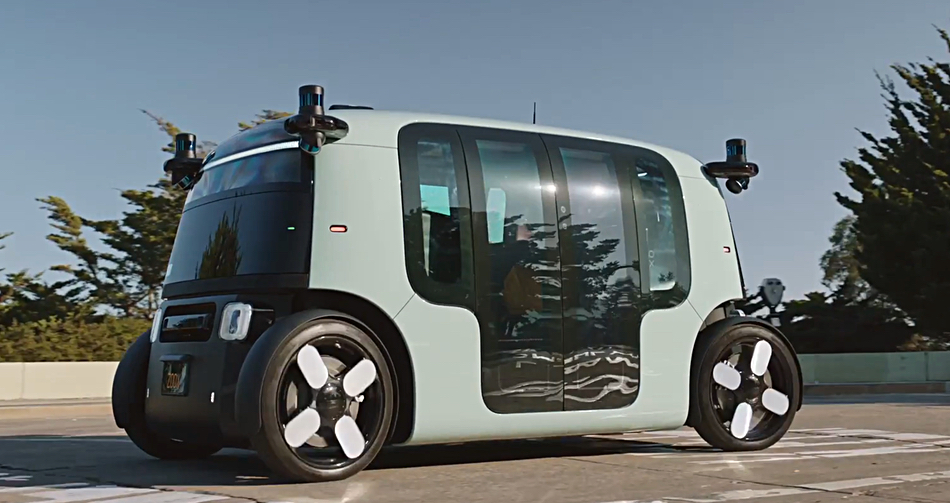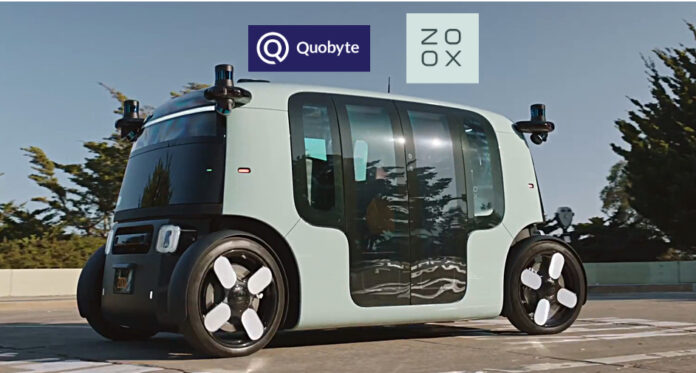Parallel file system software Quobyte is being used by robotaxi developer Zoox to store vehicle sensor and simulation data for training the AI software controlling the vehicles.
Amazon-owned Zoox competes with Google’s Waymo and Tesla’s robotaxi efforts with its urban vehicles. These have onboard GPUs and 4x Intel Xeon CPUs. They are purpose-designed, unlike Waymo’s retrofitted SUVs. It thinks it has an edge because its vehicles, which lack a steering wheel, “look more like carriages than cars, with seating for up to four passengers.” There is no front and back as the cars are bi-directional and the two pairs of passengers face each other.

Its fleet of testing vehicles in the targeted urban environments are retrofitted Toyota Highlanders equipped with the same sensor and compute packages as its robotaxis, plus a human operator. These vehicles generate driving data and validate its autonomous technology. SUVs with human safety operators run in the San Francisco Bay Area, Las Vegas, Seattle, Austin, Miami, and Los Angeles. Zoox plans to welcome public riders in Las Vegas and San Francisco later this year.
Zoox timeline
- 2014 – Zoox founded by CEO Tim Kentley-Klay and CTO Jesse Levinson who was developing self-driving tech at Stanford University. He is the son of Apple chairman Arthur Levinson
- March 2018 – raised $500 million funding taking total to $800 million
- April 2018 – Zoox fires CEO Kentley-Klay and Levinson becomes president
- Dec 2018 – Gained approval for to provide self-driving transport in California
- Jan 2019 – Ex-Intel chief strategy officer Aicha Evans hired as CEO
- April 2020 – Settled with Tesla over alleged IP exposure following the hiring of former Tesla employees
- June 2020 – Amazon acquired Zoox for >$1.2 billion and put it inside its Amazon Devices & Services organization
- July 2022 – Zoox self-certified its passenger vehicles met Federal Motor Vehicle Safety Standards (FMVSS) without the need for regulatory changes or exemption requests
- 2023 – Approved by California Department of Motor Vehicles to begin testing self-driving robotaxis on open public roads with passengers on board. Also authorized by the Nevada Department of Motor Vehicles to operate its autonomous robotaxis on public roads
- May 2024 – National Highway Traffic Safety Administration (NHTSA) opened investigation into potential flaws in Zoox vehicles after two rear-end collisions involving motorbikes and Zoox vehicles
- 2025 – Zoox has robotaxis operating in Las Vegas, Los Angeles, with Atlanta, Austin, Miami and San Francisco coming soon. It opened its first full-scale production facility for robotaxis in Hayward, CA, near Silicon Valley.

Zoox is headquartered in Foster City, CA, and its developing fleet of robotaxis will be controlled by AI software that responds to real-time radar, lidar, camera, long-wave infrared, and microphone data with the AI models trained on datasets comprising this sensor and simulation data. The AI models have a perception engine and a prediction module with planning and control systems. Zoox tests its autonomous vehicle systems in virtual environments before real-world deployment.
Although owned by Amazon, which has its AWS compute and storage cloud, Zoox has its own datacenter with compute clusters formed from thousands of Nvidia GPUs – but it does use the cloud for cold data storage and client access. The on-prem storage is needed to avoid the latency involved in cloud data transfer.
Zoox started out by using Ceph to store its data and found this problematic as the OS they used was old and Ceph kernel modules had to be upgraded for performance. They constantly exceeded their capacity and the performance was slow with outages not helping. So Zoox thought again and the data is now stored in a Quobyte scale-out parallel file system, deployed in 2020 after a proof-of-concept period in 2019, which has scaled to 30 petabytes as the datasets have grown.
The data sets include high-precision 3D renderings of geographic map data which is used for training, and to keep the vehicles inside geo-fenced urban areas. Training runs can occur every two weeks or so, and data is tiered across SSD, disk drives, and the public cloud to optimize for cost and performance.
There are three Quobyte clusters with tens of thousands of clients accessing the data through AWS. Almost an exabyte of cold data is stored in AWS and Zoox is exploring tighter integration between the Quobyte system and S3 vaults to keep costs in check.








